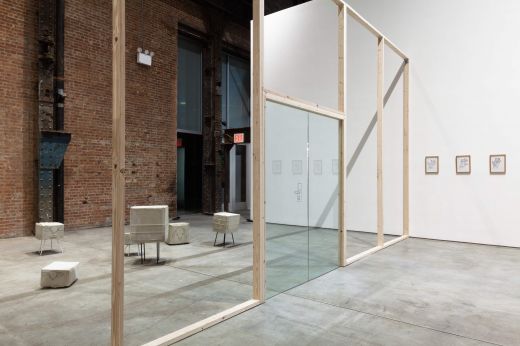
Installation view of Judith Hopf Untitled Photo courtesy of Jason Mandella.
SculptureCenter: October 2, 2014 – January 5, 2015
Stepped up the curb and on beyond the doors of the SculptureCenter, which is housed in an expanded old trolley repair shop in Long Island City, Queens, and I saw an art show called Puddle, pothole, portal, which is thickly about childhood entertainment in the United S of America and, ergo, paradox, poop jokes, and since it’s art, a didactic treatment of the comic impulse as a socioeconomic response to the ever-changing/ever-malfunctioning of technologies, bodies, systems, selves—and if the latter sounds somewhat trite, it’s intended to, buddy, since everyone and all things do in fact just grow in discrete and sometimes secret ways until their ultimate undoing, a fact which is totally sad but sorta funny, it being both the spring and the void, etc.
The show’s officiated text explicated the big points of departure for the show’s curators Ruba Katrib and artist Camille Henrot, and includes 1. Saul Steinberg, longtime cartoonist for The New Yorker and self-described “writer who draws,” 2. The 1988 film “Who Framed Roger Rabbit”, and 3. The emergence and content of cartoons in the early 20th century and their reflection of, and disruptive impacts upon, those media/entertainment complexes structural and cultural, personal, and political.
Skipped past the big wall that partly succeeded in telling me what to think and I almost landed on a 4-foot-long dark glove stretched out across the floor, c/o Olga Balema, one for a man of impossibly long arms. My near faux pas was caused by Chadwick Rantanen’s wavy immensity of a multi-story desk unit leaning against the nice brick wall of the old trolley repair shop, which drew my eyeballs up to the pens stiffly dangling off their anti-theft ball chains, and the telephone handsets suspended by their curly cords, the whole thing gesturing a bent reality of absurd obstacles to the pronouncedly more absurd (though very real) tedium of adulthood.
Also there were paintings of a little cartoon boy with words like “shit” and “pussy” printed on them in a loud, ironically commercial-though-subversive internet style! A sharp contrast to the spare, surreal illustrations by Saul Steinberg, works in a separate room from the 1960s and ‘70s, dense with satire but easy n’ classy on the lines and colors.
So, all this laughter, is it illusory? Is comedy just a veiling of our alienation, a temporary antidote for the intellectual and spiritual desperation symptomatic of stilted social relations? In its buildings, pictures, and stories, mankind is preparing to outlive culture, if need be. And the main thing is that it does so with a laugh. This laughter may occasionally sound barbaric. Well and good. — Walter Benjamin, what a goofball!
Another work on the ground floor, by Judith Hopf, consisted of two-by-fours making up the frame of a large wall you could step through, and in the middle was a pair of glass doors with a hand-drawn doorknob. A statement on cartoons as worlds of different laws where life and death and everything in-between are one-liners, it reveals the screen as a place to play upon and see with. But it also shows it as an obstruction, an omnipresent metaphysical turnstile with which we have no choice but to experience the world.
After falling down the stairs into the basement I saw the exhibition take a delightfully stranger turn. The long creepy corridors of the old trolley repair shop proved perfect for displaying Abigail DeVille’s meat industry-style conveyer belt of garbage, bones, and prosthetics bathed in party lights, as well as Antoine Catala’s gorgeous emoticon robots who, with their parentheses and semicolons swirling, were the cutest little anthropomorphized metacomms one could hope to see.
Such were the lewder hymns of the many works in the show, those which played more directly with the repressed unpleasantries of childhood and entertainment, those hybridic realms with contingencies round every corner and erogenous and fatal potentials in the body, mind and object equally, that grey-to-dark zone which all humor, however lite, skims the surface of, begging the question what came first: the need to laugh, or the bleakness that fills a room after such hearty roars?










